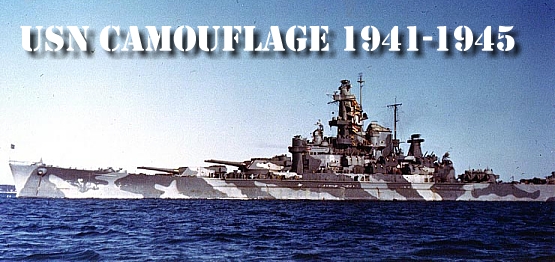
An online database of camouflage used by
United State Naval Warships during WWII
|
|
|
THE
DEVELOPMENT OF NAVAL CAMOUFLAGE 1914-1945 In
the Mediterranean in late 1944 British destroyers began to have the roof area of
their bridges painted a bright yellow in order to assist recognition by friendly
aircraft. One of the ships so painted was the Hunt class destroyer BELVOIR. On
her first trip with this feature she was bombed in error (without result) by an
American Liberator bomber. Upon the ship returning to port the captain sought
out the aircraft responsible, the crew of which explained that the yellow areas
had made an excellent aiming point, and that they were unaware of the use of
yellow as an aid to aircraft recognition. The captain of BELVOIR had the yellow
areas painted back to the standard grey! One
of the most singular instances of recognition markings as an aid to aircraft
occurred in September 1943 at the invasion of Salerno, involving the British
cruiser UGANDA. Of the cruisers on the gun line, the UGANDA was about the most
heavily fitted with anti-aircraft weaponry, so the UGANDA’s captain decided to
paint the roofs of the three triple 6” turrets gloss white. In this way he
felt that the enemy aircraft would pick out the UGANDA, attack the ship,
and be shot down because of UGANDA’s ability to put up a very heavy
concentration of anti-aircraft fire! UGANDA had this feature for about ten days
while giving close support for troops ashore. At the end of this time the turret
roofs were painted back to the normal color. It was reported to the author that
the crew breathed a collective sigh of relief when this happened! On
at least one occasion vessel IFF markings were used to try to deceive the
enemy! The case in point was the wearing of diagonal bands of red and white
across the bows of the British destroyers SIKH and ZULU during the commando raid
on Tobruk on the night of 13/14 September 1942. During the raid itself, the SIKH
was sunk by AA batteries ashore, and ZULU was sunk a few hours later by aircraft
while retreating from the scene. MUNSELL
BOOK OF COLORS For
those modelers who wish to view the Munsell Book of Colors, 1929 edition, the
following institutions hold a copy. This is by no means a complete list. Check
with your local university library or public library system. There are many
more, and probably one is available in your area. (I)
U,S. Postal Service Library - Washington D.C. NOTES
ON ARTWORK Because
of the tremendous variety of styles, types, and ship by ship variation, the
following illustrations represent only a tiny sample of British camouflage usage
during World War II. These ships patterns shown here are ones that have never
been published before and are split between official and unofficial designs,
with some interesting variations mixed in. Readers may notice in some instances
the tonal qualities are different from the correct ones. As the artwork is
reproduced in black and white, it was necessary in order to distinguish easily
between colors. A good example of this is the pattern for the cruiser KENYA,
where the difference in tone on the artwork between the two shades of
Mountbatten Pink has been exaggerated. Although
some pieces of art are of outline only, they are reasonably accurate and the
arrangement of patterns can be used with a degree of confidence. For those
wishing to construct detailed models, a degree of research will be required in
order to ascertain precise configuration. The author hopes that in these cases,
the results will be shared through publication. The
camouflage worn by the destroyers ROCKINGHAM MONTGOMERY, and HIGHLANDER,
illustrates well the types of variations of the Peter Scott style of camouflage,
whereby the concealment aspect has largely been lost through the use of dark
tones. Evidence strongly suggests that the use of unof6cial colors and patterns
on escorts was widespread in 1941,1942, and well into 1943. |